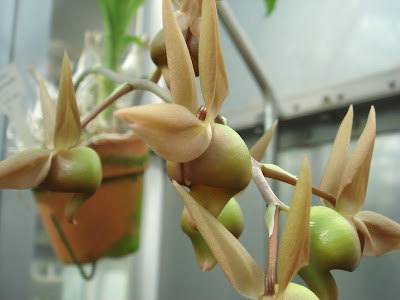Catasetum fuchsii is found in Northeastern Bolivia into Brazil (states of Goiás, Mato Grosso do Sul, southern Tocantins, and Pará). It grows in dry forest on rolling countryside, to the east of the rain forest in Bolivia and on into Brazil. In Goiás State, it often grows on palms, while farther north it grows on other trees.
Catasetum fuchsii also called as Fuchs Catasetum, is a species of the genus Catasetum. This species was described by Calaway H. Dodson & Roberto Vásquez in 1982.
IDENTIFY CATASETUM FUCHSII ORCHID PLANT
Catasetum fuchsii is found in Northeastern Bolivia into Brazil (states of Goiás, Mato Grosso do Sul, southern Tocantins, and Pará). It grows in dry forest on rolling countryside, to the east of the rain forest in Bolivia and on into Brazil. In Goiás State, it often grows on palms, while farther north it grows on other trees.
It is a medium sized, hot to warm growing epiphyte with clustered, fusiform, slightly compressed, 18 cm long and 3.8 cm wide pseudobulbs enveloped completely by dry leaf sheaths and carrying to 7, linear-oblanceolate, medium green, plicate, 3 prominent veined, to 40 cm long and 8.5 cm wide leaves.
Fuchs Catasetum blooms in the late summer to late fall either on a male, arching then pendant, 43 cm long, several flowered inflorescence or a shorter and thicker female inflorescence carrying very fleshy, rigid flowers and often with successive inflorescence that arise over a few months. The male flowers are 44 × 72 mm with coloration of sepals and petals pale olive green, with considerable tan; lip darker, more green below, more brown above, orange inside with heavy brown longitudinal striping; column pearly white; other clones range from red-brown to dull yellow-green to white. The female flowers are with coloration green, with darker green on the upper edge of the stigmatic cavity.
The key to identify this species is the lip base globose with a triangular-shaped apical lobe and strongly recurved lateral sepals. The flowers are usually unspotted. This fairly common species has several color forms, including a white one. The species has been confused with Catasetum albovirens because of the unique lip shape, but its flowers are larger and resupinate, and its inflorescence is arching and pendent.
CATASETUM FUCHSII ORCHID PLANT CARE AND CULTURE
Cultural information should only be used as a guide, and should be to be adapted to suit you. Your physical location; where you grow your plants, how much time you have to devote to their care, and many other factors, will need to be taken into account. Only then can you decide on the cultural methods that best suit you and your plants.
Light:
Catasetum fuchsii are sun-loving plant and needs a light level of 30000-60000 lux. Unless the strong air movement found in the natural habitat can be duplicated, however, the grower should provide some shade (40-60 % shade). This species can be grown under lights if sufficient light intensity can be provided, and the plant certainly can be summered outdoors if their moisture requirements can be met.
Temperature:
The climate in their natural habitat is essentially continental. The dry season is long and the humidity is very low throughout much of the year. Days are hot and dry, while nights are fairly cool. The terrain is typically tropical to subtropical savannah country, with the surface soil shallow and incapable of sustaining large trees. Temperatures range from a maximum 40°C to a minimum 10°C. In cultivation, 18°C is the ideal minimum night temperature.
Humidity:
Fuchs Catasetum tolerate an environment with 40 - 60 % relative humidity during their growing season, but for optimal development of new growth and flowering, 70 % is recommended.
Substrate, growing media and repotting:
Catasetum fuchsii can be grown in pot, container or wooden basket with fir bark, osmunda, tree fern fiber, charcoal, and sphagnum, in various proportions or combined with still other ingredients such as sponge rock, perlite, leaf mold, peat, and bark screenings as substrate.
It is recommended to repot every year and never wait more than two years. The optimal time for potting or repotting is when new growth on a plant emerging from dormancy is about 5 cm tall and the nubs have developed into new roots that are reaching for support.
Watering:
In its natural habitat it receives rainfall frequently even while dormant. Basket-grown, and unconventionally potted plant may be watered every sunny day during the growing season, provided conditions are such that they dry off relatively quickly. In the case of conventionally potted adult plants, it should not be necessary to water more than once or, at most, twice a week. This species like to dry out at least slightly between waterings.
Fertilizer:
Fertilize with an appropriate formulation at least every week during the growing season, or fertilize with a weak formula every time the plants are watered. It is important to begin regular applications of high-nitrogen fertilizer (such as 10-5-5) with a full range of trace elements. As the leaves begin to unfurl, and well before flowering, add a high-phosphorus formula to develop big, strong pseudobulbs capable of producing robust inflorescences. Any of the soluble products with a large second-digit number (for example, 3-12-6) constitute a good source of phosphorus.
Rest period:
Catasetum fuchsii accustomed to a fairly long dry season. When the plants are leafless and no new growths are visible, the grower must respect their state of dormancy. Watering frequency should be reduced during dormancy. Fertilization should stop completely during this period. In the springtime, at the beginning of the growth cycle, water should not be made regularly available for the newly developing roots until the new growth is at least 5 cm tall.















COMMENTS